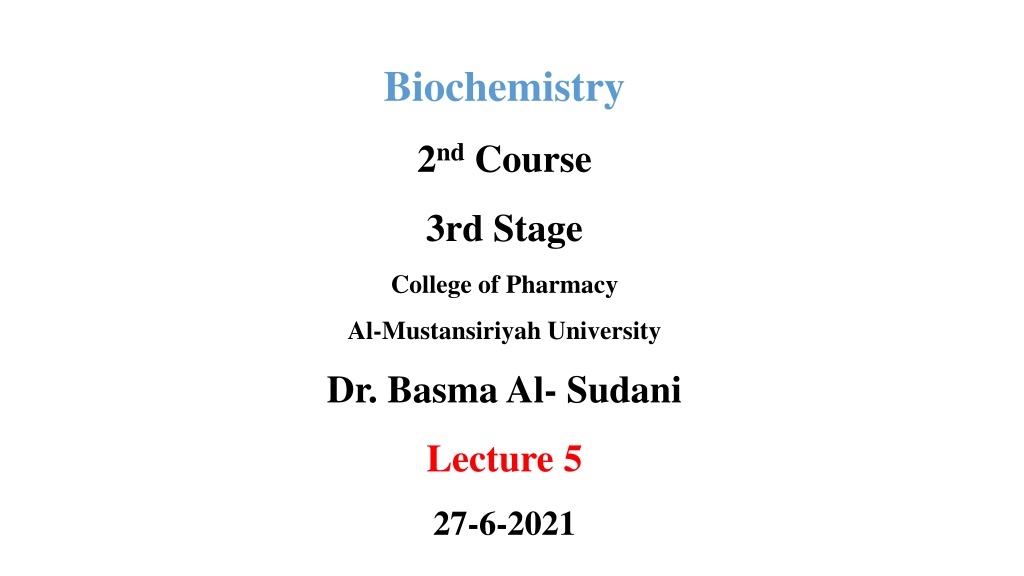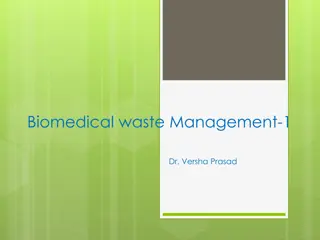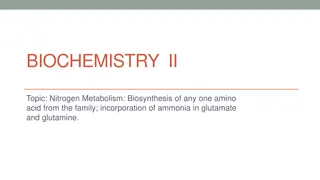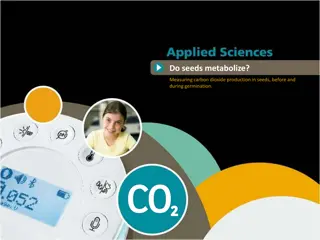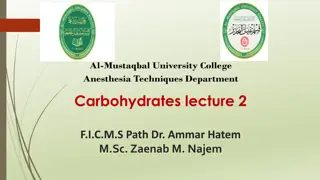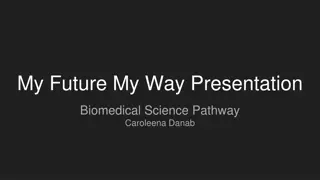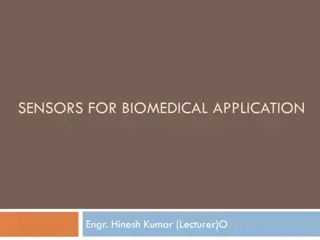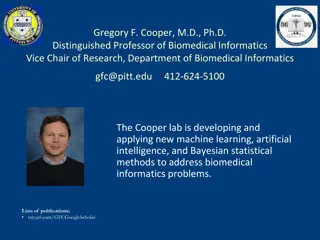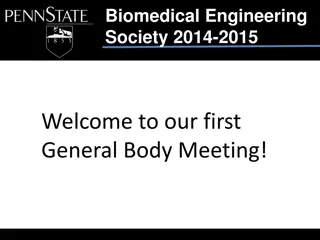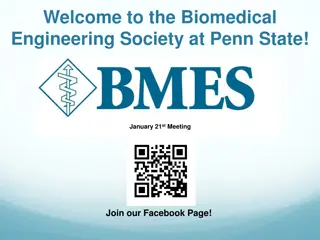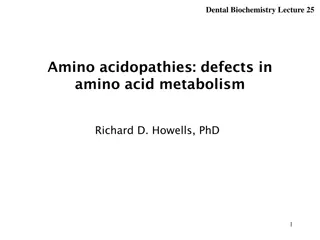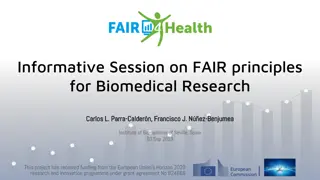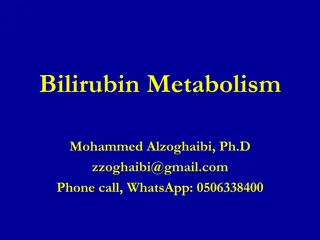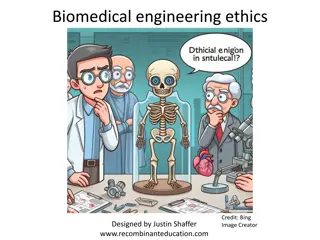Understanding Xenobiotic Metabolism for Biomedical Applications
Metabolism of xenobiotics, foreign chemicals like drugs, food additives, and pollutants, is crucial for pharmacology, toxicology, and disease management. Knowledge allows for beneficial applications such as antioxidant research, pollutant conversion, and drug biosynthesis using transgenic organisms. Xenobiotic metabolism involves two phases, with liver playing a key role in rendering compounds water-soluble for excretion. Hydroxylation and other reactions modify xenobiotics, making them biologically active or inert, impacting human health.
Download Presentation

Please find below an Image/Link to download the presentation.
The content on the website is provided AS IS for your information and personal use only. It may not be sold, licensed, or shared on other websites without obtaining consent from the author. Download presentation by click this link. If you encounter any issues during the download, it is possible that the publisher has removed the file from their server.
E N D
Presentation Transcript
Biochemistry 2nd Course 3rd Stage College of Pharmacy Al-Mustansiriyah University Dr. Basma Al- Sudani Lecture 5 27-6-2021
Metabolism of Xenobiotics BIOMEDICAL IMPORTANC Xenobiotics are a wide variety of foreign chemicals , both naturally occurring compounds in plant foods, and synthetic compounds in medicines, food additives, and environmental pollutants. Knowledge of the metabolism of xenobiotics is essential for an understanding of pharmacology and therapeutics, toxicology, and the management of disease. All these areas involve either the administration of, or exposure to, xenobiotics. Many of the xenobiotics in plant foods have potentially beneficial effects and knowledge of their metabolism will permit extrapolation from in vitro measurement of antioxidant activity to in vivo protective action. Understanding the mechanisms involved in xenobiotic metabolism will permit the development of transgenic microorganisms and plants containing genes that encode enzymes for the metabolism of specific compounds that can be used to convert potentially hazardous pollutants to harmless compounds. Similarly, transgenic organisms may be used for biosynthesis of drugs and other chemicals.
MANY XENOBIOTICS THAT MUST BE METABOLIZED BEFORE BEING EXCRETED A xenobiotic (Gk xenos stranger ) is a compound that is foreign to the body. The principal classes of xenobiotics of medical relevance are drugs, chemical carcinogens, naturally occurring compounds in plant foods, and various compounds that have found their way into our environment by one route or another, such as polychlorinated biphenyls (PCBs), insecticides and other pesticides. More than 200,000 manufactured environmental chemicals exist. Most of these compounds are subject to metabolism, mainly in the liver. While the metabolism of xenobiotics is generally considered to be a process of detoxification, sometimes the metabolites of compounds that are themselves inert or harmless are biologically active. This may be desirable, as in the activation of a prodrug to the active compound, or it may be undesirable, as in the formation of a carcinogen or mutagen from an inert precursor. The metabolism of xenobiotics is generally considered in two phases. In phase 1, the major reaction involved is hydroxylation, catalyzed mainly by members of a class of enzymes referred to as monooxygenases or cytochromes P450. Hydroxylation may terminate the action of a drug, though this is not always the case. In addition to hydroxylation, these enzymes catalyze a wide range of reactions, including those involving deamination, dehalogenation, desulfuration, epoxidation, peroxygenation, and reduction. Reactions involving hydrolysis (eg, catalyzed by esterases) and certain other nonP450-catalyzed reactions also occur in phase 1. Phase 1 metabolism renders compounds more reactive, introducing groups that can be conjugated with glucuronic acid, sulfate, acetate, glutathione, or amino acids in phase 2 metabolism. This produces polar compounds that are watersoluble and can therefore readily be excreted in urine or bile. Very hydrophobic xenobiotics would persist in adipose tissue almost indefinitely if they were not converted to more polar forms.
In some cases, phase 1 metabolic reactions convert xenobiotics from inactive to biologically active compounds. In these instances, the original xenobiotics are referred to as prodrugs or procarcinogens. Sometimes, additional phase 1 reactions (eg, further hydroxylation reactions) convert these active compounds into less active or inactive forms prior to conjugation. In yet other cases, it is the conjugation reactions themselves that convert the active products of phase 1 reactions to less active or inactive compounds, which are excreted. In a very few cases, conjugation may increase the biological activity of a xenobiotic.
ISOFORMS OF CYTOCHROME P450 HYDROXYLATE A MYRIAD OF XENOBIOTICS IN PHASE 1 OF THEIR METABOLISM The main reaction involved in phase 1 metabolism is hydroxylation, catalyzed by a family of enzymes known as monooxygenases or cytochromes P450. There are at least 57 cytochrome P450 genes in the human genome. Cytochrome P450 is a heme enzyme. It is so named because it was originally discovered when it was noted that preparations of microsomes (fragments of the endoplasmic reticulum) that had been chemically reduced and then exposed to carbon monoxide exhibited an absorption peak at 450 nm. Approximately 50% of the common drugs that humans ingest are metabolized by isoforms of cytochrome P450. They also act on steroid hormones, carcinogens, and pollutants. The major cytochromes P450 in drug metabolism are members of the CYP1, CYP2, and CYP3 families. In addition to their role in metabolism of xenobiotics, cytochromes P450 are important in the metabolism of a number of physiological compounds for example, the synthesis of steroid hormones and the conversion of vitamin D to its active metabolite, calcitriol. The overall reaction catalyzed by a cytochrome P450 is: RH + O2 + NADPH + H+ R-OH + H2 O + NADP The role of NADPH is to reduce cytochrome P450; the reduced cytochrome then reduces oxygen to water and the hydroxyl group that is introduced into the substrate. The reaction mechanism is complex. Using 18O2 it has been shown that one atom of oxygen forms the hydroxyl group of R OH and the other forms water. This dual fate of the oxygen accounts for the former naming of monooxygenases as mixed-function oxidases.
Isoforms of Cytochrome P450 Make Up a Superfamily of Heme-Containing Enzymes Because of the large number of isoforms of cytochrome P450 that have been discovered (about 150, in a wide range of organisms, including bacteria), it is important to have a systematic nomenclature for the enzymes and their genes. It is based on amino acid sequence homology of the enzymes. The abbreviated root symbol CYP denotes a cytochrome P450. This is followed by an Arabic numeral designating the family; cytochromes P450 are included in the same family if they exhibit 40% or more amino acid sequence identity. The Arabic number is followed by a capital letter indicating the subfamily; P450s are in the same subfamily if they exhibit greater than 55% sequence identity. The individual P450s are then assigned Arabic numerals in their subfamily. Thus, CYP1A1 denotes a cytochrome P450 that is a member of family 1 and subfamily A and is the first individual member of that subfamily. The nomenclature for the genes encoding cytochrome P450s is the same, except that italics are used; thus, the gene encoding CYP1A1 is CYP1A1. The families of cytochrome P450 in human tissues, and their principal functions, are shown in Table 1. In mammals, cytochromes P450 are present in highest amount in liver cells and enterocytes but are probably present in all tissues.
In liver and most other tissues, they are present mainly in the membranes of the smooth endoplasmic reticulum, which constitute part of the microsomal fraction when tissue is subjected to subcellular fractionation. In hepatic microsomes, cytochromes P450 can comprise as much as 20% of the total protein. P450s are found in most tissues, though often in low amounts compared with liver. In the adrenal gland, they are found in mitochondria as well as in the endoplasmic reticulum; the various hydroxylases present in the gland are involved in cholesterol and steroid hormone biosynthesis. The mitochondrial cytochrome P450 system differs from the microsomal system in that it uses an NADPH-linked flavoprotein, adrenodoxin reductase, and a nonheme iron-sulfur protein, adrenodoxin. In addition, the P450 isoforms involved in steroid biosynthesis are generally much more restricted in their substrate specificity. Not only is there a wide variety of cytochromes P450, but they also have overlapping substrate specificities, so that a very broad range of xenobiotics can be metabolized by one or other of the cytochromes P450. NADPH, not NADH, is involved in the reaction mechanism of cytochrome P450, in a reaction catalyzed by NADPHcytochrome P450 reductase. Electrons are transferred from NADPH to NADPH-cytochrome P450 reductase and then to cytochrome P450. This leads to the reductive activation of molecular oxygen, and one atom of oxygen is subsequently inserted into the substrate. Cytochrome b5 , another hemoprotein found in the membranes of the smooth endoplasmic reticulum, may be involved as an electron donor in some cases. Most isoforms of cytochrome P450 are inducible. For instance, the administration of phenobarbital or other drugs causes hypertrophy of the smooth endoplasmic reticulum and a three- to fourfold increase in the amount of cytochrome P450 within 4 to 5 days. In most cases this involves increased transcription of mRNA.
However, in some cases, induction involves stabilization of mRNA or the enzyme protein itself, or an increase in the translation of mRNA. Induction of cytochrome P450 underlies drug interactions, when the effects of one drug are altered by prior, concurrent, or later administration of another. For example, the anticoagulant warfarin is metabolized by CYP2C9, which is induced by phenobarbital. Induction of CYP2C0 by phenobarbital will increase the metabolism of warfarin, so reducing its efficacy, and the dose must be increased. Another example involves CYP2E1, which is induced by consumption of ethanol. This P450 metabolizes some widely used solvents and compounds found in tobacco smoke, many of which are established procarcinogens. If the activity of CYP2E1 induced by ethanol, this may increase the risk of carcinogenicity. Naturally occurring compounds in foods may also affect cytochrome P450. Grapefruit contains a variety of furanocoumarins, which inhibit cytochrome P450 and so affect the metabolism of many drugs. Some drugs are activated by cytochrome P450, so that grapefruit will reduce their activity; others are inactivated by cytochrome P450, so that grapefruit increases their activity. Drugs that are affected include statins, omeprazole, antihistamines and benzodiazepine antidepressants. Polymorphism of cytochromes P450 may explain much of the variations in drug responses noted among many patients variants with low catalytic activity will lead to slower metabolism of the substrate, and hence prolonged drug action and accumulation of the drug in the body. One interesting polymorphism is that of CYP2A6, which is involved in the metabolism of nicotine to conitine. Three CYP2A6 alleles have been identified: a wild type and two null or inactive alleles. It has been reported that individuals with the null alleles, who have impaired metabolism of nicotine, are apparently protected against becoming tobacco-dependent smokers. These individuals smoke less, presumably because their blood and brain concentrations of nicotine remain elevated longer than those of individuals with the wild-type allele. It has been speculated that inhibiting CYP2A6 may provide a novel way to help smoking cessation.
